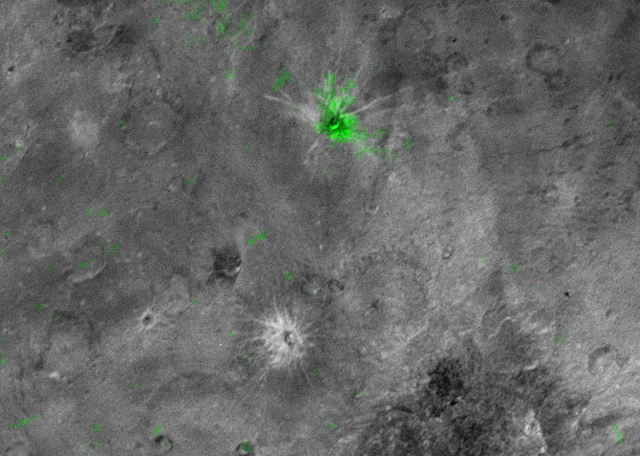jeudi 29 octobre 2015
A Full View of Pluto’s Stunning Crescent & The Youngest Crater on Charon?
NASA - New Horizons Mission logo.
Oct. 29, 2015
In September, the New Horizons team released a stunning but incomplete image of Pluto’s crescent. Thanks to new processing work by the science team, New Horizons is releasing the entire, breathtaking image of Pluto. Image Credits: NASA/JHUAPL/SwRI.
This image was made just 15 minutes after New Horizons’ closest approach to Pluto on July 14, 2015, as the spacecraft looked back at Pluto toward the sun. The wide-angle perspective of this view shows the deep haze layers of Pluto's atmosphere extending all the way around Pluto, revealing the silhouetted profiles of rugged plateaus on the night (left) side. The shadow of Pluto cast on its atmospheric hazes can also be seen at the uppermost part of the disk. On the sunlit side of Pluto (right), the smooth expanse of the informally named icy plain Sputnik Planum is flanked to the west (above, in this orientation) by rugged mountains up to 11,000 feet (3,500 meters) high, including the informally named Norgay Montes in the foreground and Hillary Montes on the skyline. Below (east) of Sputnik, rougher terrain is cut by apparent glaciers.
The backlighting highlights more than a dozen high-altitude layers of haze in Pluto’s tenuous atmosphere. The horizontal streaks in the sky beyond Pluto are stars, smeared out by the motion of the camera as it tracked Pluto. The image was taken with New Horizons' Multi-spectral Visible Imaging Camera (MVIC) from a distance of 11,000 miles (18,000 kilometers) to Pluto. The resolution is 700 meters (0.4 miles).
The Youngest Crater on Charon?
New Horizons scientists have discovered a striking contrast between one of the fresh craters on Pluto’s largest moon Charon and a neighboring crater dotting the moon’s Pluto-facing hemisphere.
Image above: Charon’s Young Ammonia Crater. The informally named Organa crater (shown in green) is rich in frozen ammonia and – so far – appears to be unique on Pluto’s largest moon. Image Credits: NASA/JHUAPL/SwRI.
The crater, informally named Organa, caught scientists’ attention as they were studying the highest-resolution infrared compositional scan of Charon. Organa and portions of the surrounding material ejected from it show infrared absorption at wavelengths of about 2.2 microns, indicating that the crater is rich in frozen ammonia – and, from what scientists have seen so far, unique on Pluto’s largest moon. The infrared spectrum of nearby Skywalker crater, for example, is similar to the rest of Charon's craters and surface, with features dominated by ordinary water ice.
Image above: This composite image is based on observations from the New Horizons Ralph/LEISA instrument made at 10:25 UT (6:25 a.m. EDT) on July 14, 2015, when New Horizons was 50,000 miles (81,000 kilometers) from Charon. The spatial resolution is 3 miles (5 kilometers) per pixel. The LEISA data were downlinked Oct. 1-4, 2015, and processed into a map of Charon's 2.2 micron ammonia-ice absorption band. Long Range Reconnaissance Imager (LORRI) panchromatic images used as the background in this composite were taken about 8:33 UT (4:33 a.m. EDT) July 14 at a resolution of 0.6 miles (0.9 kilometers) per pixel and downlinked Oct. 5-6. The ammonia absorption map from LEISA is shown in green on the LORRI image. The region covered by the yellow box is 174 miles across (280 kilometers). Image Credits: NASA/JHUAPL/SwRI.
Using telescopes, scientists first observed ammonia absorption on Charon in 2000, but the concentrations of ammonia around this crater are unprecedented.
"Why are these two similar-looking and similar-sized craters, so near to each other, so compositionally distinct?" asked Will Grundy, New Horizons Composition team lead from Lowell Observatory in Flagstaff, Arizona. "We have various ideas when it comes to the ammonia in Organa. The crater could be younger, or perhaps the impact that created it hit a pocket of ammonia-rich subsurface ice. Alternatively, maybe Organa’s impactor delivered its own ammonia."
Both craters are about the same size – roughly 5 kilometers [3 miles] in diameter – with similar appearances, including bright wisps or rays of ejected material, or ejecta. One apparent difference is that Organa has a central region of darker ejecta, though from the map created with data from New Horizons’ Ralph/LEISA instrument, it appears that the ammonia-rich material extends beyond this dark area.
“This is a fantastic discovery,” said Bill McKinnon, deputy lead for the New Horizons Geology, Geophysics and Imaging team from Washington University in St. Louis. “Concentrated ammonia is a powerful antifreeze on icy worlds, and if the ammonia really is from Charon’s interior, it could help explain the formation of Charon’s surface by cryovolcanism, via the eruption of cold, ammonia-water magmas.”
For more information about New Horizons mission, visit: http://www.nasa.gov/mission_pages/newhorizons/main/index.html
Images (mentioned), Text, Credits: NASA/Tricia Talbert.
Best regards, Orbiter.ch




